CHEVROLET CAMARO 1967 1.G Chassis Workshop Manual
Manufacturer: CHEVROLET, Model Year: 1967, Model line: CAMARO, Model: CHEVROLET CAMARO 1967 1.GPages: 659, PDF Size: 114.24 MB
Page 621 of 659
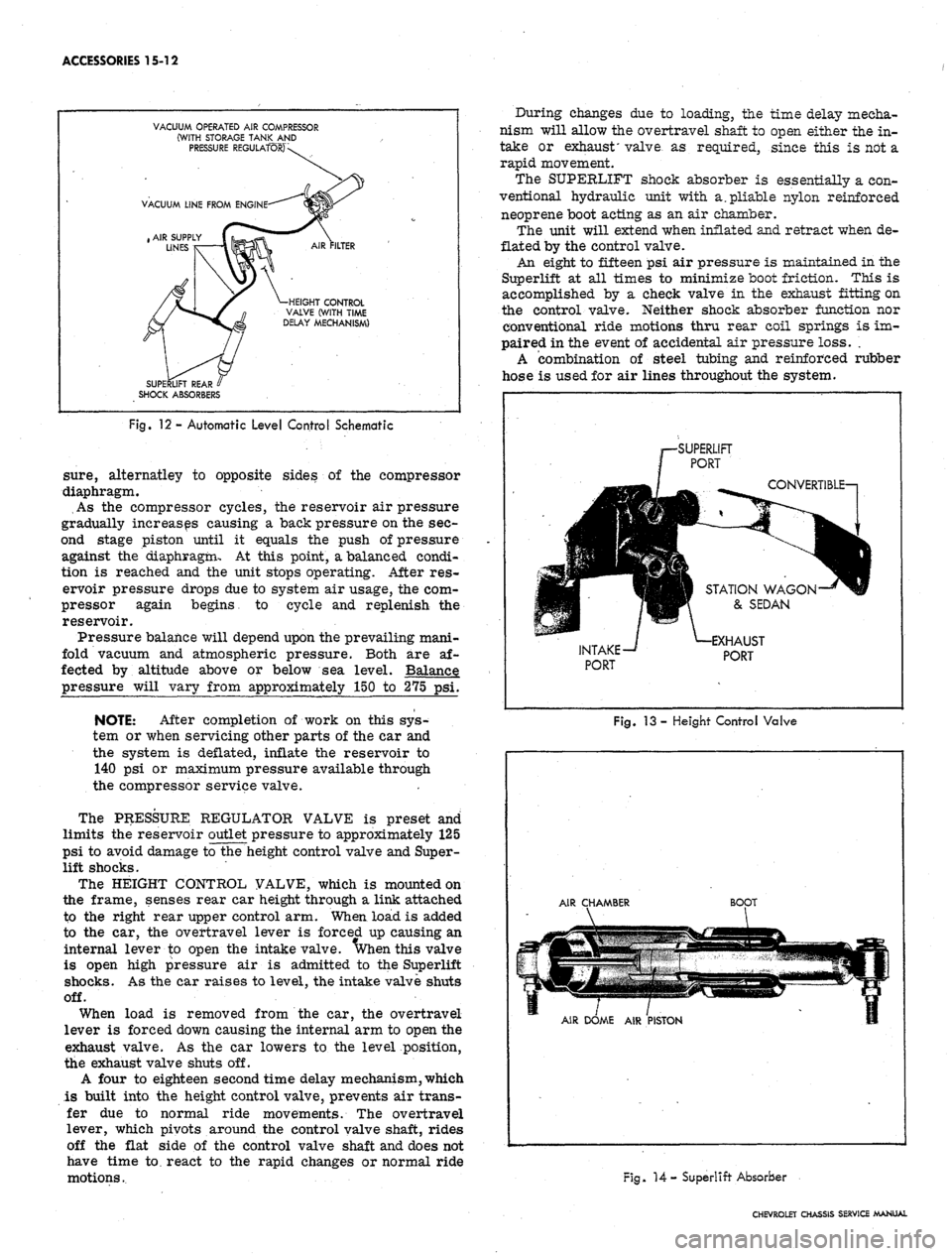
ACCESSORIES 15-12
VACUUM
(WIT
P
VACUUM Llh
, AIR SUPPt
LINES
t
SUPERLIFT F
SHOCK ABSO
OPERATED AIR COMPRESSOR
H STORAGE TANK AND
RESSURE REGULATORJV
\A
4E FROM ENG«NE^"^
/ \-HEIGHT CONTROL
•^-Z n VALVE (WITH TIME
^*
EAR II
RBERS
Fig.
12 - Automatic Level Control Schematic
sure,
alternatley to opposite sides of the compressor
diaphragm.
As the compressor cycles, the reservoir air pressure
gradually increases causing a back pressure on the sec-
ond stage piston until it equals the push of pressure
against the diaphragm- At this point, a balanced condi-
tion is reached and the unit stops operating. After res-
ervoir pressure drops due to system air usage, the com-
pressor again begins to cycle and replenish the
reservoir.
Pressure balance will depend upon the prevailing mani-
fold vacuum and atmospheric pressure. Both are af-
fected by altitude above or below sea level. Balance
pressure will vary from approximately 150 to 275 psi.
NOTE: After completion of work on this sys-
tem or when servicing other parts of the car and
the system is deflated, inflate the reservoir to
140 psi or maximum pressure available through
the compressor service valve.
The PRESSURE REGULATOR VALVE is preset and
limits the reservoir outlet pressure to approximately 125
psi to avoid damage to the height control valve and Super-
lift shocks.
The HEIGHT CONTROL VALVE, which is mounted on
the frame, senses rear car height through a link attached
to the right rear upper control arm. When load is added
to the car, the overtravel lever is forced up causing an
internal lever to open the intake valve, when this valve
is open high pressure air is admitted to the Superlift
shocks. As the car raises to level, the intake valve shuts
off.
When load is removed from the car, the overtravel
lever is forced down causing the internal arm to open the
exhaust valve. As the car lowers to the level position,
the exhaust valve shuts off.
A four to eighteen second time delay mechanism, which
is built into the height control valve, prevents air trans-
fer due to normal ride movements. The overtravel
lever, which pivots around the control valve shaft, rides
off the flat side of the control valve shaft and does not
have time to. react to the rapid changes or normal ride
motions.
During changes due to loading, the time delay mecha-
nism will allow the overtravel shaft to open either the in-
take or exhaust' valve as required, since this is not a
rapid movement.
The SUPERLIFT shock absorber is essentially a con-
ventional hydraulic unit with a. pliable nylon reinforced
neoprene boot acting as an air chamber.
The unit will extend when inflated and retract when de-
flated by the control valve.
An eight to fifteen psi air pressure is maintained in the
Superlift at all times to minimize boot friction- This is
accomplished by a check valve in the exhaust fitting on
the control valve. Neither shock absorber function nor
conventional ride motions thru rear coil springs is im-
paired in the event of accidental air pressure loss. .
A combination of steel tubing and reinforced rubber
hose is used for air lines throughout the system.
-SUPERLIFT
PORT
STATION WAGON
& SEDAN
INTAKE
PORT
HAUST
PORT
Fig. 13 - Height Control Valve
AIR CHAMBER
BOOT
AIR DOME AIR PISTON
Fig. 14- Superlift Absorber
CHEVROLET CHASSIS SERVICE MANUAL
Page 622 of 659
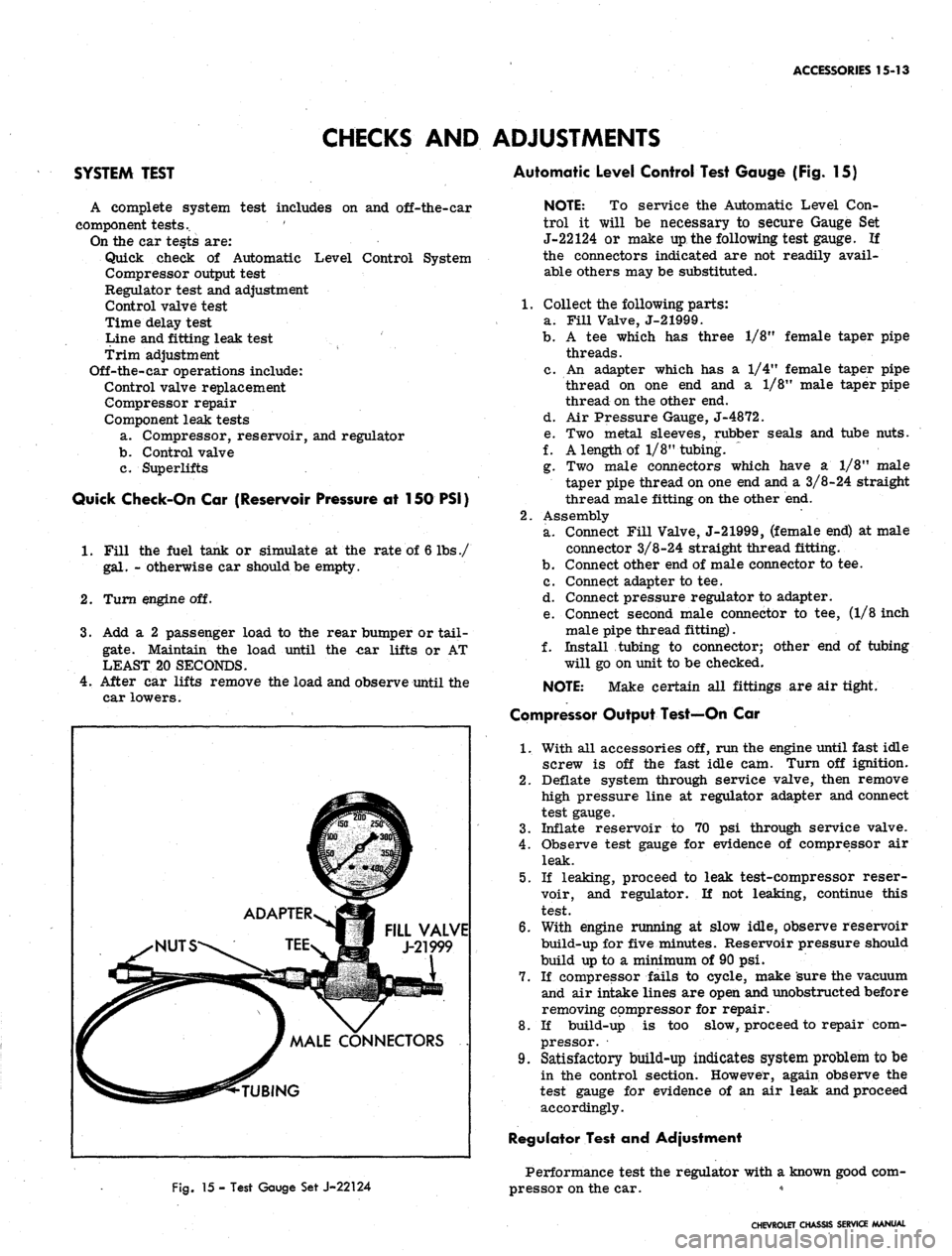
ACCESSORIES 15-13
SYSTEM TEST
CHECKS AND ADJUSTMENTS
Automatic Level Control Test Gauge (Fig. 15)
A complete system test includes on and off-the-car
component tests.. '
On the car tests are:
Quick check of Automatic Level Control System
Compressor output test
Regulator test and adjustment
Control valve test
Time delay test
Line and fitting leak test
Trim adjustment
Off-the-car operations include:
Control valve replacement
Compressor repair
Component leak tests
a. Compressor, reservoir, and regulator
b.
Control valve
c. Superlifts
Quick Check-On Car (Reservoir Pressure at 150 PSI)
1.
Fill the fuel tank or simulate at the rate of 6 lbs./
gal.
- otherwise car should be empty.
2.
Turn engine off.
3.
Add a 2 passenger load to the rear bumper or tail-
gate.
Maintain the load until the -car lifts or AT
LEAST 20 SECONDS.
4.
After car lifts remove the load and observe until the
car lowers.
FILL VALVE
J-21999
CONNECTORS
Fig.
15 - Test Gauge Set J-22124
NOTE: To service the Automatic Level Con-
trol it will be necessary to secure Gauge Set
J-22124 or make up the following test gauge. If
the connectors indicated are not readily avail-
able others may be substituted.
1.
Collect the following parts:
a. Fill Valve, J-21999.
b.
A tee which has three 1/8M female taper pipe
threads.
c. An adapter which has a 1/4" female taper pipe
thread on one end and a 1/8" male taper pipe
thread on the other end.
d. Air Pressure Gauge, J-4872.
e. Two metal sleeves, rubber seals and tube nuts.
f. A length of 1/8" tubing. ~
g. Two male connectors which have a 1/8" male
taper pipe thread on one end and a 3/8-24 straight
thread male fitting on the other end.
2.
Assembly
a. Connect Fill Valve, J-21999, (female end) at male
connector 3/8-24 straight thread fitting.
b.
Connect other end of male connector to tee.
c. Connect adapter to tee.
d. Connect pressure regulator to adapter.
e. Connect second male connector to tee, (1/8 inch
male pipe thread fitting).
f. Install tubing to connector; other end of tubing
will go on unit to be checked.
NOTE:
Make certain all fittings are air tight.
Compressor Output Test—On Car
1.
With all accessories off, run the engine until fast idle
screw is off the fast idle cam. Turn off ignition.
2.
Deflate system through service valve, then remove
high pressure line at regulator adapter and connect
test gauge.
3.
Inflate reservoir to 70 psi through service valve.
4.
Observe test gauge for evidence of compressor air
leak.
5.
If leaking, proceed to leak test-compressor reser-
voir, and regulator. If not leaking, continue this
test.
6. With engine running at slow idle, observe reservoir
build-up for five minutes. Reservoir pressure should
build up to a minimum of 90 psi.
7.
If compressor fails to cycle, make sure the vacuum
and air intake lines are open and unobstructed before
removing compressor for repair.
8. If build-up is too slow, proceed to repair com-
pressor.
9. Satisfactory build-up indicates system problem to be
in the control section. However, again observe the
test gauge for evidence of an air leak and proceed
accordingly.
Regulator Test and Adjustment
Performance test the regulator with a known good com-
pressor on the car. *
CHEVROLET CHASSIS SERVICE MANUAL
Page 623 of 659

ACCESSORIES 15-14
Deflate system through service valve and disconnect
line at pressure regulator valve. Install test gauge on
regulator valve high pressure fitting.
Inflate system through service valve to maximum
available pressure.
NOTE: If available pressure is less than 140
psi,
start engine to build-up reservoir to this
pressure.
Regulated pressure should build-up to and hold
steady at 100-130 psi on test gauge.
Check regulated pressure by momentarily (not more
than one second) depressing valve core on test gauge
arid observe gauge reading.
If regulated pressure now reads less than 100 psi,
replace regulator assembly.
If regulated pressure exceeds 130 psi, replace regu-
lator assembly.
Control Valve Test
Exhaust (Superlifts Inflated)
1.
Disconnect control valve lever from link.
2.
Hold lever down in exhaust position until Superlifts
deflate or for a minimum of 18 seconds.
3.
If Superlifts deflate, perform Intake Check.
4.
If Superlifts do not deflate, remove exhaust adapter
from control valve and hold lever down as in Step 2.
Replace adapter, O-ring and filter if this deflates
Superlifts.
5.
Replace control valve if none of the above steps solve
problem.
Intake (Reservoir Pressure 125 psi Minimum)
1.
Disconnect overtravel lever from link.
2.
Hold lever up in intake position until Superlifts in-
Fig.
16 - Assembly Leak Test Preparation
flate or for a minimum of fifteen seconds.
3.
If Superlifts inflate and hold, proceed to Time Delay
Check. '•
4.
If Superlifts inflate and then leak down, perform leak
test on lines and fittings and then on Superlifts and
control valve. Repair or replace as indicated.
Time Delay Test (Reservoir Pressure 125 psi Minimum)
1.
Record rear trim height of empty car (rear bumper
to ground).
2.
Add weight equivalent to two passenger load to rear
of car. Car should begin to level in 4-18 seconds.
3.
Remove weight. After 4-18 seconds car should begin
to settle.
4.
Replace valve if time delay is not within the 4-18
seconds.
Trim Adjustment—On Car
Trim adjustment should be performed with a full fuel
tank (or the equivalent in load at the rate of 6 lbs
./gal-
lon)
,
but no other load.
Abbreviated Adjustment
1.
Fill the compressor at the service valve with the
available air line pressure.
2.
Disconnect link from height control valve lever.
Move the height control valve lever upward until air
fills the Superlifts.
3.
Move lever downward and hold until air stops escap-
ing from the exhaust port of the height control valve.
The Superlifts will now automatically hold 8 to 15
PSI.
;
4.
Let lever go to its neutral position> and loosen the
lever adjustment nut.
5.
Assemble the link to the height control valve lever
and tighten the lever adjustment nut.
NOTE: Do not move control valve lever and
overtravel body while tightening nut.
Leak Tests
Compressor, Reservoir and Regulator
1.
Remove assembly intact.
2.
Connect test gauge to regulator. Inflate reservoir
through service valve to 80-110 psi.
3.
Route an 8" rubber hose between vacuum and vent
ports,
(fig. 16).
4.
Submerge in water and observe for air leaks at:
Reservoir weld seam.
Reservoir to compressor O-ring.
Regulator to compressor O-ring.
Regulator boot-defective internal.O-rihg.
Diaphragm between first and second stage housings.
' Tightening through bolts may correct the leak.
Cover gasket and retainer screw. A few bubbles here
is not a leak. A continuous stream indicates defec-
tive compressor check valves.
Service valve.
Test gauge connections.
5.
Correct any leaks detected by either tightening
screws or replacing parts.
CHEVROLET CHASSIS SERVICE MANUAL
Page 624 of 659
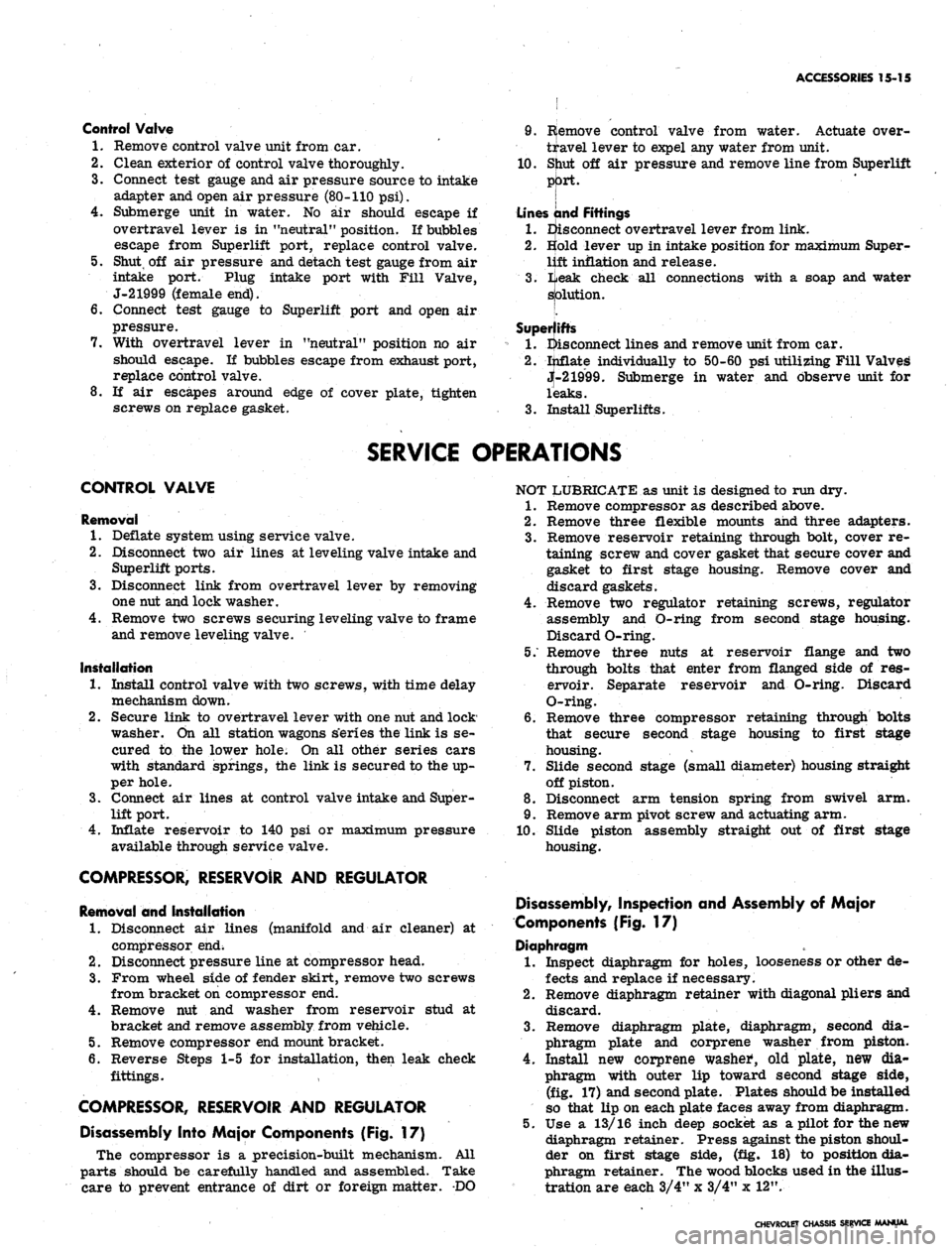
ACCESSORIES 15-15
Control Valve
1.
Remove control valve unit from car.
2.
Clean exterior of control valve thoroughly.
3.
Connect test gauge and air pressure source to intake
adapter and open air pressure (80-110 psi).
4.
Submerge unit in water. No air should escape if
overtravel lever is in "neutral" position. If bubbles
escape from Superlift port, replace control valve.
5. Shut, off air pressure and detach test gauge from air
intake port. Plug intake port with Fill Valve,
J-21999 (female end).
6. Connect test gauge to Superlift port and open air
pressure.
7. With overtravel lever in "neutral" position no air
should escape. If bubbles escape from exhaust port,
replace control valve.
8. If air escapes around edge of cover plate, tighten
screws on replace gasket.
9. R(emove control valve from water. Actuate over-
travel lever to expel any water from unit.
10.
Sjiut off air pressure and remove line from Superlift
[
Lines and Fittings
1.
Eisconnect overtravel lever from link.
2.
Bold lever up in intake position for maximum Super-
lift inflation and release.
3.
iieak check all connections with a soap and water
splution.
[.
Superlifts
1.
disconnect lines and remove unit from car.
2.
ijiflate individually to 50-60 psi utilizing Fill Valves
jt-21999. Submerge in water and observe unit for
leaks.
3.
Install Superlifts.
SERVICE OPERATIONS
CONTROL VALVE
Removal
1.
Deflate system using service valve.
2.
Disconnect two air lines at leveling valve intake and
Superlift ports.
3.
Disconnect link from overtravel lever by removing
one nut and lock washer.
4.
Remove two screws securing leveling valve to frame
and remove leveling valve.
Installation
1.
Install control valve with two screws, with time delay
mechanism down.
2.
Secure link to overtravel lever with one nut and lock
washer. On all station wagons s'eries the link is se-
cured to the lower hole. On all other series cars
with standard springs, the link is secured to the up-
per hole.
3.
Connect air lines at control valve intake and Super-
lift port.
4.
Inflate reservoir to 140 psi or maximum pressure
available through service valve.
COMPRESSOR, RESERVOIR AND REGULATOR
Removal and Installation
1.
Disconnect air lines (manifold and air cleaner) at
compressor end;
2.
Disconnect pressure line at compressor head.
3.
From wheel side of fender skirt, remove two screws
from bracket on compressor end.
4.
Remove nut and washer from reservoir stud at
bracket and remove assembly from vehicle.
5. Remove compressor end mount bracket.
6. Reverse Steps 1-5 for installation, then leak check
fittings.
COMPRESSOR, RESERVOIR AND REGULATOR
Disassembly Into Major Components (Fig. 17)
The compressor is a precision-built mechanism. All
parts should be carefully handled and assembled. Take
care to prevent entrance of dirt or foreign matter. DO
NOT LUBRICATE as unit is designed to run dry.
1.
Remove compressor as described above.
2.
Remove three flexible mounts and three adapters.
3.
Remove reservoir retaining through bolt, cover re-
taining screw and cover gasket that secure cover and
gasket to first stage housing. Remove cover and
discard gaskets.
4.
Remove two regulator retaining screws, regulator
assembly and O-ring from second stage housing.
Discard O-ring.
5/ Remove three nuts at reservoir flange and two
through bolts that enter from flanged side of res-
ervoir. Separate reservoir and O-ring. Discard
O-ring.
6. Remove three compressor retaining through bolts
that secure second stage housing to first stage
housing.
7. Slide second stage (small diameter) housing straight
off piston.
8. Disconnect arm tension spring from swivel arm.
9. Remove arm pivot screw and actuating arm.
10.
Slide piston assembly straight out of first stage
housing.
Disassembly, Inspection and Assembly of Major
Components (Fig. 17)
Diaphragm
1.
Inspect diaphragm for holes, looseness or other de-
fects and replace if necessary.
2.
Remove diaphragm retainer with diagonal pliers and
discard.
3.
Remove diaphragm plate, diaphragm, second dia-
phragm plate and corprene washer from piston.
4.
Install new corprene washed, old plate, new dia-
phragm with outer lip toward second stage side,
(fig. 17) and second plate. Plates should be installed
so that lip on each plate faces away from diaphragm.
5. Use a 13/16 inch deep socket as a pilot for the new
diaphragm retainer. Press against the piston shoul-
der on first stage side, (fig. 18) to position dia-
phragm retainer. The wood blocks used in the illus-
tration are each 3/4" x 3/4" x 12".
CHEVROLET CHASSIS SERVICE MANUAL
Page 625 of 659
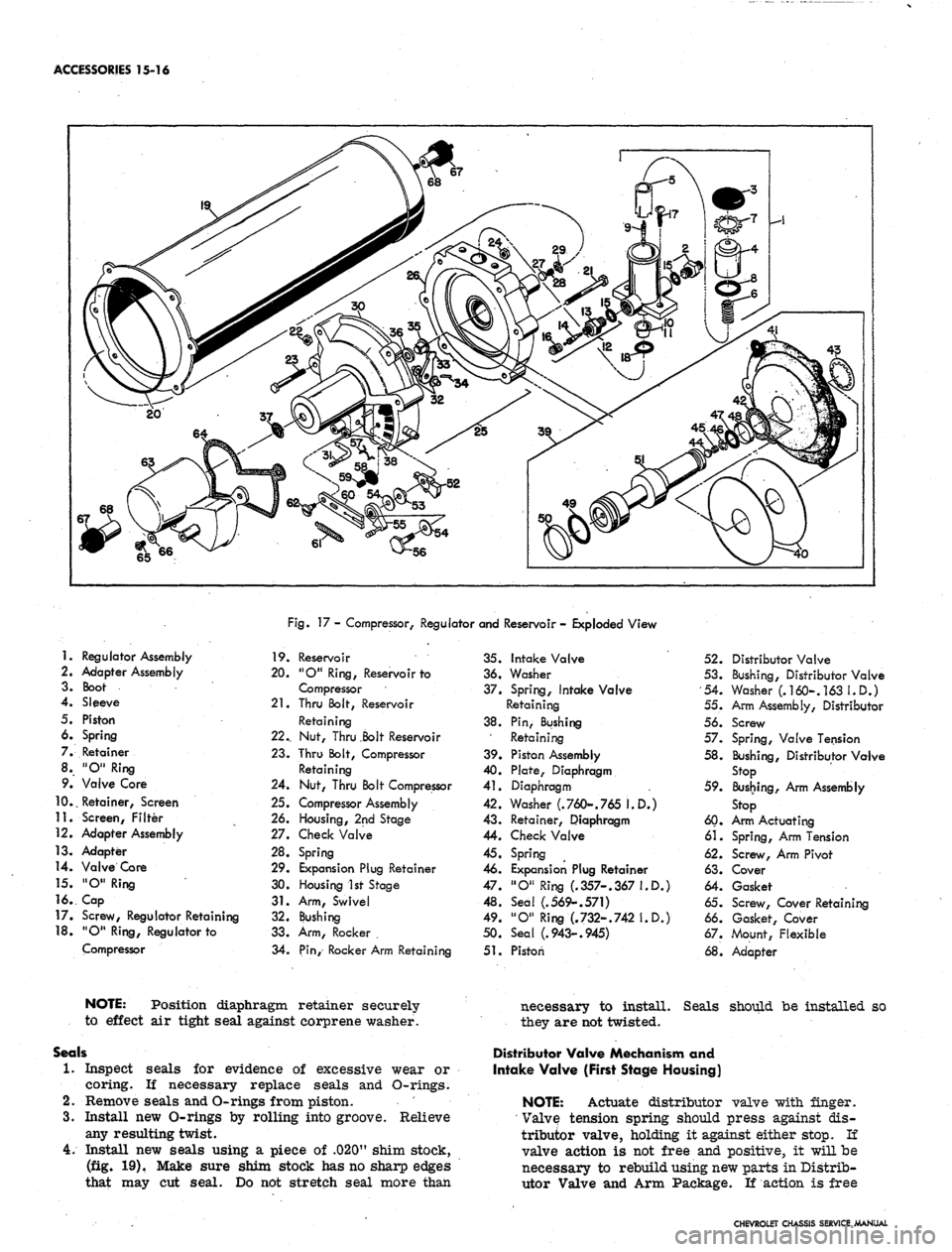
ACCESSORIES 15-16
Fig.
17 - Compressor, Regulator and Reservoir - Exploded View
1.
Regulator Assembly
2.
Adapter Assembly
3. Boot
4.
Sleeve
5. Piston
6. Spring
7. Retainer
8. "O" Ring
9. Valve Core
10..
Retainer, Screen
11.
Screen, Filter
12.
Adapter Assembly
13.
Adapter
14.
Valve Core
15.
"O" Ring
16..
Cap
17.
Screw, Regulator Retaining
18.
"O" Ring, Regulator to
Compressor
19.
Reservoir
20.
"O" Ring, Reservoir to
Compressor
21.
Thru Bolt, Reservoir
Retaining
22.,
Nut, Thru .Bolt Reservoir
23.
Thru Bolt, Compressor
Retaining
24.
Nut, Thru Bolt Compressor
25.
Compressor Assembly
26.
Housing, 2nd Stage
27.
Check Valve
28.
Spring
29.
Expansion Plug Retainer
30.
Housing 1st Stage
31.
Arm, Swivel
32.
Bushing
33.
Arm, Rocker .
34.
Pin, Rocker Arm Retaining
35.
Intake Valve
36,
Washer
37.
Spring, Intake Valve
Retaining
38.
Pin, Bushing
Retaining
39.
Piston Assembly
40.
Plate, Diaphragm
41.
Diaphragm
42.
Washer (.760-.765 I.D.)
43.
Retainer, Diaphragm
44.
Check Valve
45.
Spring
46.
Expansion Plug Retainer
47.
"O" Ring (.357-.367 I.D.)
48.
Seal (.569-.571)
49.
"O" Ring (.732-.742 I.D.)
50.
Seal (.943-.945)
51.
Piston
52.
Distributor Valve
53.
Bushing, Distributor Valve
54.
Washer (.160-. 163 I.D.)
55. Arm Assembly, Distributor
56. Screw
57. Spring, Valve Tension
58.
Bushing, Distributor Valve
Stop
59. Bussing, Arm Assembly
Stop
60.
Arm Actuating
61.
Spring, Arm Tension
62.
Screw, Arm Pivot
63.
Cover
64.
Gasket
65. Screw, Cover Retaining
66. Gasket, Cover
67. Mount, Flexible
68.
Adapter
NOTE: Position diaphragm retainer securely
to effect air tight seal against corprene washer.
Seals
1.
Inspect seals for evidence of excessive wear or
coring. If necessary replace seals and O-rings.
2.
Remove seals and O-rings from piston.
3.
Install new O-rings by rolling into groove. Relieve
any resulting twist.
4.
Install new seals using a piece of .020" shim stock,
(fig. 19). Make sure shim stock has no sharp edges
that may cut seal. Do not stretch seal more than
necessary to install. Seals should be installed so
they are not twisted.
Distributor Valve Mechanism and
Intake Valve (First Stage Housing)
NOTE: Actuate distributor valve with finger.
' Valve tension spring should press against dis-
tributor valve, holding it against either stop. If
valve action is not free and positive, it will be
necessary to rebuild using new parts in Distrib-
utor Valve and Arm Package. If action is free
CHEVROLET CHASSIS SERVICE MANUAL
Page 626 of 659
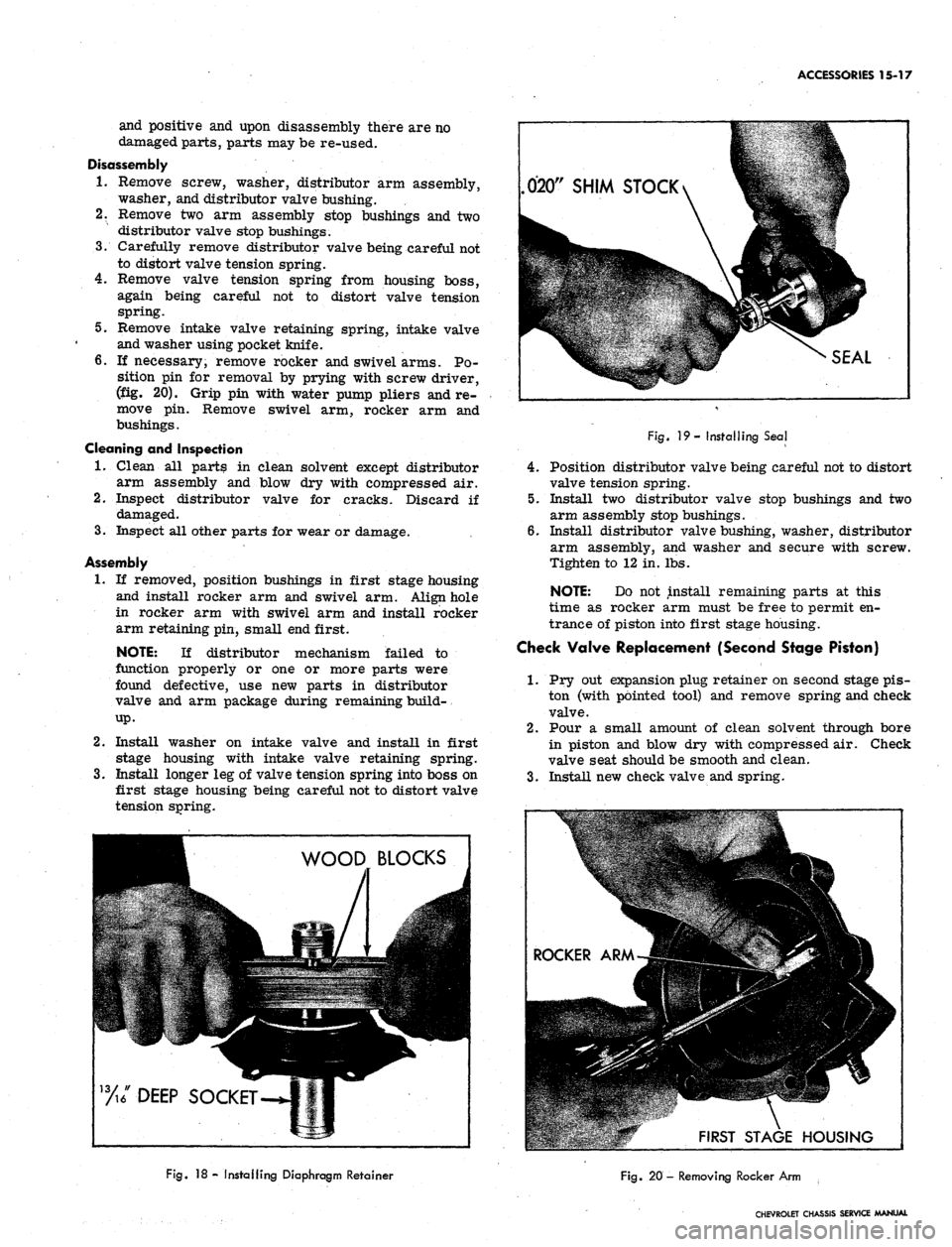
ACCESSORIES 15-17
and positive and upon disassembly there are no
damaged parts, parts may be re-used.
Disassembly
1.
Remove screw, washer, distributor arm assembly,
washer, and distributor valve bushing.
2.
Remove two arm assembly stop bushings and two
distributor valve stop bushings.
3.
Carefully remove distributor valve being careful not
to distort valve tension spring.
4.
Remove valve tension spring from housing boss,
again being careful not to distort valve tension
spring.
5.
Remove intake valve retaining spring, intake valve
and washer using pocket knife.
6. If necessary, remove rocker and swivel arms. Po-
sition pin for removal by prying with screw driver,
(fig. 20). Grip pin with water pump pliers and re-
move pin. Remove swivel arm, rocker arm and
bushings.
Cleaning and Inspection
1.
Clean all parts in clean solvent except distributor
arm assembly and blow dry with compressed air.
2.
Inspect distributor valve for cracks. Discard if
damaged.
3.
Inspect all other parts for wear or damage.
Assembly
1.
If removed, position bushings in first stage housing
and install rocker arm and swivel arm. Align hole
in rocker arm with swivel arm and install rocker
arm retaining pin, small end first.
NOTE: If distributor mechanism failed to
function properly or one or more parts were
found defective, use new parts in distributor
valve and arm package during remaining build-
up.
2.
Install washer on intake valve and install in first
stage housing with intake valve retaining spring.
3.
Install longer leg of valve tension spring into boss on
first stage housing being careful not to distort valve
tension spring.
020"
SHIM STOCK
SEAL
Fig.
19- Installing Seal
4.
Position distributor valve being careful not to distort
valve tension spring.
5.
Install two distributor valve stop bushings and two
arm assembly stop bushings.
6. Install distributor valve bushing, washer, distributor
arm assembly, and washer and secure with screw.
Tighten to 12 in. lbs.
NOTE: Do not install remaining parts at this
time as rocker arm must be free to permit en-
trance of piston into first stage housing.
Check Valve Replacement (Second Stage Piston)
1.
Pry out expansion plug retainer on second stage pis-
ton (with pointed tool) and remove spring and check
valve.
2.
Pour a small amount of clean solvent through bore
in piston and blow dry with compressed air. Check
valve seat should be smooth and clean.
3.
Install new check valve and spring.
%/DEEP SOCKET
ROCKER /
WHgggb
I
^RM-j|
111511
FIRST
m
H
STAGE
1 Mill IMW •
W
HOUSING
Fig.
18- Installing Diaphragm Retainer
Fig.
20 - Removing Rocker Arm ,
CHEVROLET CHASSIS SERVICE MANUAL
Page 627 of 659
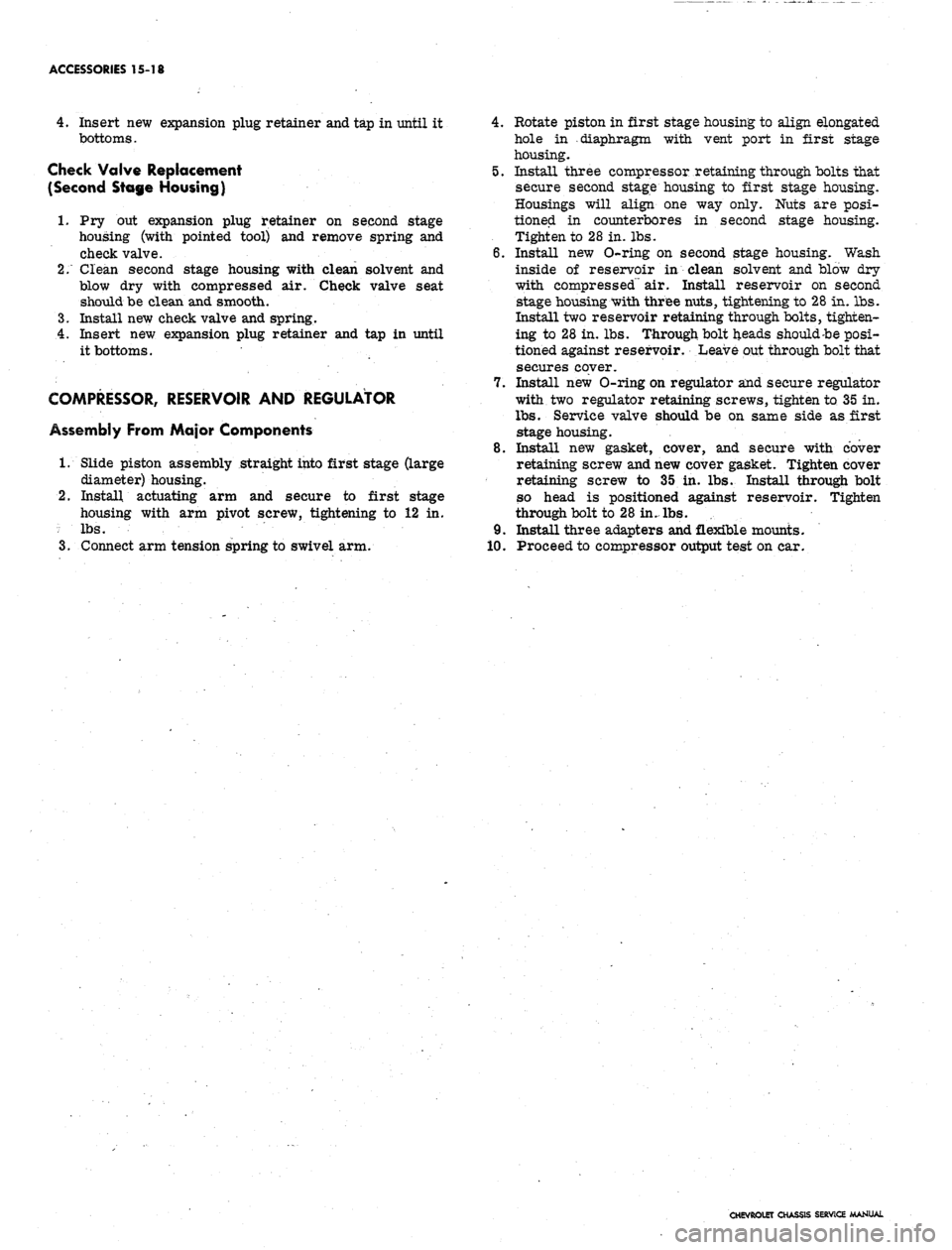
ACCESSORIES 15-18
4.
Insert new expansion plug retainer and tap in until it
bottoms.
Check Valve Replacement
(Second Stage Housing)
1.
Pry out expansion plug retainer on second stage
housing (with pointed tool) and remove spring and
check valve.
2.
Glean second stage housing with clean solvent and
blow dry with compressed air. Check valve seat
should be clean and smooth.
3.
Install new check valve and spring.
4.
Insert new expansion plug retainer and tap in until
it bottoms.
COMPRESSOR, RESERVOIR AND REGULATOR
Assembly From Major Components
1.
Slide piston assembly straight into first stage (large
diameter) housing.
2.
Install actuating arm and secure to first stage
housing with arm pivot screw, tightening to 12 in.
: lbs. ;
3.
Connect arm tension spring to swivel arm.
9.
10.
Rotate piston in first stage housing to align elongated
hole in diaphragm with vent port in first stage
housing.
Install three compressor retaining through bolts that
secure second stage housing to first stage housing.
Housings will align one way only. Nuts are posi-
tioned in counterbores in second stage housing.
Tighten to 28 in. lbs.
Install new O-ring on second stage housing. Wash
inside of reservoir in clean solvent and blow dry
with compressed" air. Install reservoir on second
stage housing with three nuts, tightening to 28 in. lbs.
Install two reservoir retaining through bolts, tighten-
ing to 28 in. lbs. Through, bolt heads should-be posi-
tioned against reservoir. Leave out through bolt that
secures cover.
Install new O-ring on regulator and secure regulator
with two regulator retaining screws, tighten to 35 in.
lbs.
Service valve should be on same side as first
stage housing.
Install new gasket, cover, and secure with cover
retaining screw and new cover gasket. Tighten cover
retaining screw to 35 in. lbs. Install through bolt
so head is positioned against reservoir. Tighten
through bolt to 28 in. lbs.
Install three adapters and flexible mounts.
Proceed to compressor output test on car.
CHEVROLET CHASSIS SERVICE MANUAL
Page 628 of 659
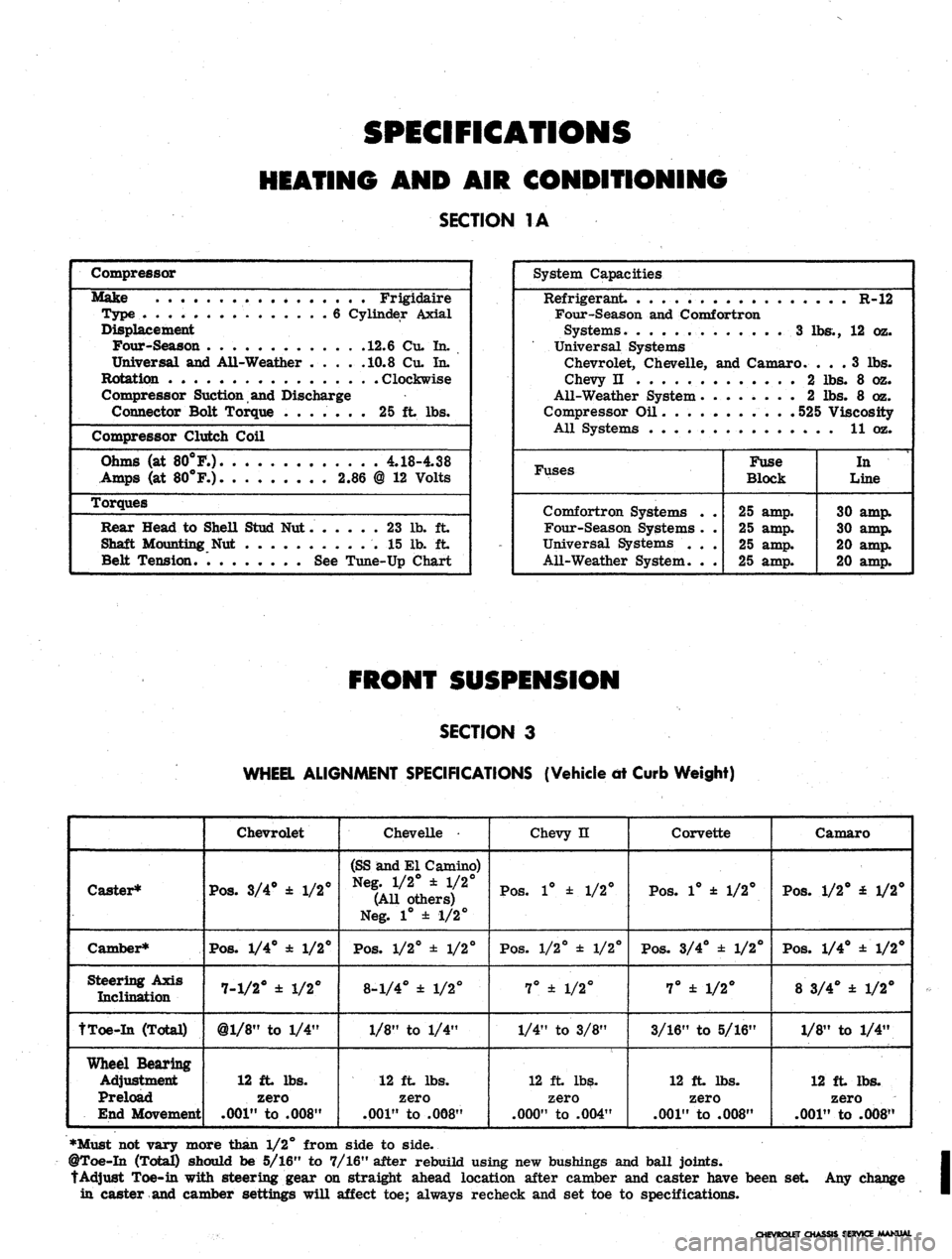
SPECIFICATIONS
HEATING
AND AIR
CONDITIONING
SECTION
1A
Compressor
Make Frigidaire
Type
. 6
Cylinder Axial
Displacement
Four-Season
12.6
Cu.
In.
Universal
and
Ail-Weather
.... .10.8 Cu. In.
Rotation Clockwise
Compressor Suction
and
Discharge
Connector Bolt Torque
.......
25 ft lbs.
Compressor Clutch Coil
Ohms
(at
80°F.).
4.18-4.38
Amps
(at
80°F.)
2.86 @ 12
Volts
Torques
Rear Head
to
SheU Stud
Nut 23 lb. ft
Shaft Mounting
Nut 15 lb. ft
Belt Tension.
See
Tune-Up Chart
System Capacities
Refrigerant
R-12
Four-Season
and
Comfortron
Systems.
............
3 lbs., 12 oz.
Universal Systems
Chevrolet, Chevelle,
and
Camaro.
... 3 lbs.
Chevy
n 2 lbs. 8 oz.
All-Weather System
2 lbs. 8 oz.
Compressor
Oil 525
Viscosity
All Systems
11 oz.
Fuses
Comfortron Systems
.
Four-Season Systems
.
Universal Systems
. .
All-Weather System.
.
Fuse
Block
25
amp.
25
amp.
25
amp.
25
amp.
In
Line
30
amp.
30
amp.
20
amp.
20
amp.
SECTION
3
WHEEL ALIGNMENT SPECIFICATIONS (Vehicle
dt
Curb Weight)
Caster*
Camber*
Steering Axis
Inclination
tToe-In (Total)
Wheel Bearing
Adjustment
Preload
End Movement
Chevrolet
Pos.
3/4° ± 1/2°
Pos.
1/4° ± 1/2°
7-1/2° ± 1/2°
@l/8"
to 1/4"
12 ft lbs.
zero
.001"
to .008"
Chevelle •
(SS and El Camino)
Neg. 1/2° ± 1/2°
(All others)
Neg. 1° ± 1/2°
Pos.
1/2° ± 1/2°
8-1/4° ± 1/2°
1/8" to 1/4"
12 ft lbs.
zero
.001"
to .008"
Chevy n
Pos.
1° ± 1/2°
Pos.
1/2° ± 1/2°
7° ± 1/2°
1/4" to 3/8"
12 ft lbs.
zero
.000"
to .004"
Corvette
Pos.
1° ± 1/2°
Pos.
3/4° ± 1/2°
7° ± 1/2°
3/16" to 5/16"
12 ft lbs.
zero
.001"
to .008"
Camaro
Pos.
1/2° £ 1/2°
Pos.
1/4° ±1/2°
8 3/4° ± 1/2°
1/8" to 1/4"
12 ft lbs.
zero
.001"
to .008"
•Must not vary more than 1/2° from side to side.
@Toe-In (Total) should be 5/16" to 7/16" after rebuild using new bushings and ball joints.
tAdjust Toe-in with steering gear on straight ahead location after camber and caster have been set Any change
in caster and camber settings will affect toe; always recheck and set toe to specifications.
LET CHASSIS SERVICE MANUAL
Page 629 of 659
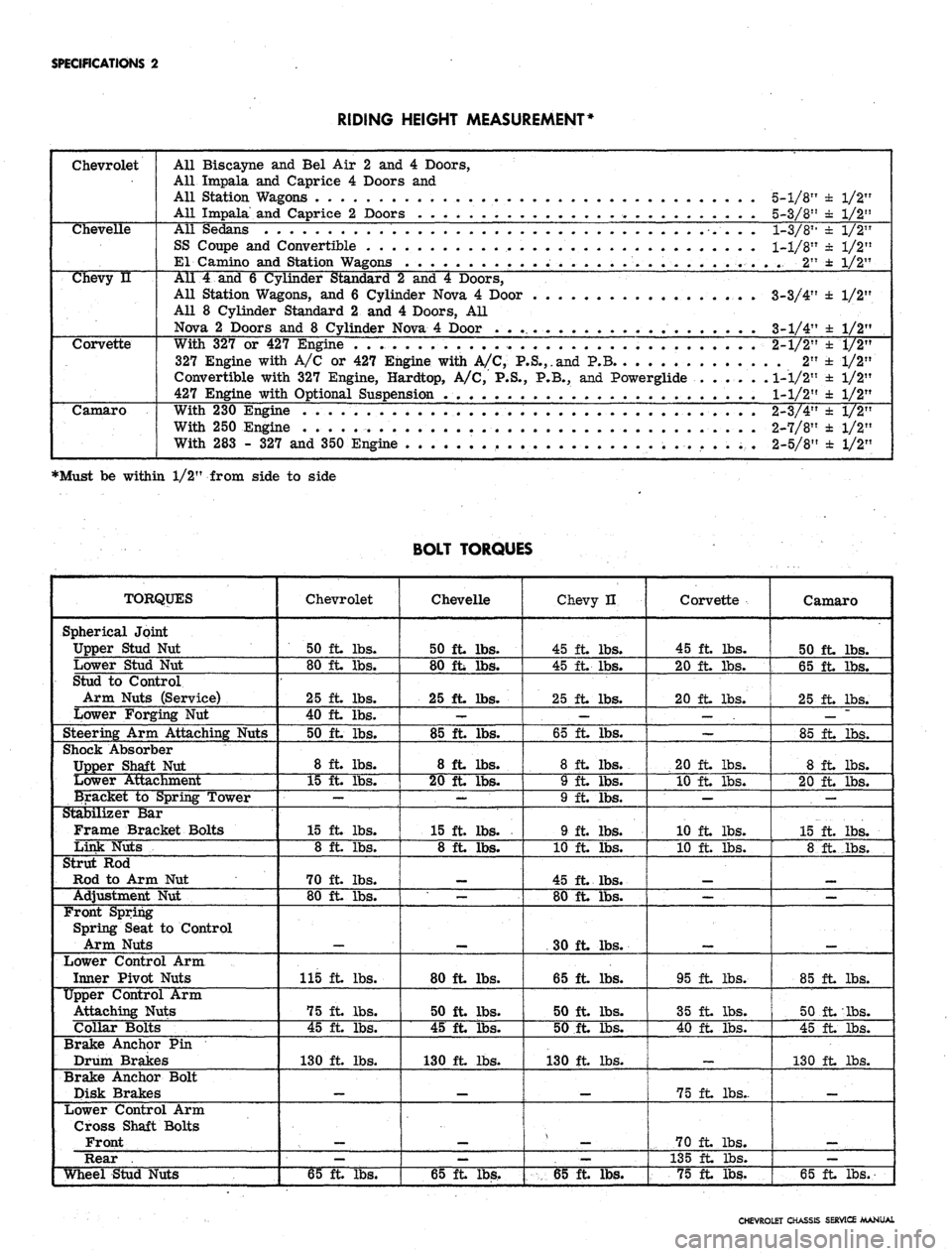
SPECIFICATIONS
2
RIDING HEIGHT MEASUREMENT*
Chevrolet
All Biscayne
and Bel Air 2 and 4
Doors,
All Impala
and
Caprice
4
Doors
and
All Station Wagons
. . . .
All Impala
and
Caprice
2
Doors
. . . . .
5-1/8"
± 1/2"
5-3/8"
± 1/2"
Chevelle
All Sedans
SS Coupe
and
Convertible
El Camino
and
Station W*
1-3/811
± 1/2"
1-1/8"
± 1/2"
..
2" ± 1/2"
Chevy
u
All
4 and 6
Cylinder Standard
2 and 4
Doors,
All Station Wagons,
and 6
Cylinder Nova
4
Door
All
8
Cylinder Standard
2 and 4
Doors,
All
Nova
2
Doors
and 8
Cylinder Nova
4
Door
. . .
3-3/4'
3-1/4'
±
1/2'
±
1/2'
Corvette
With
327 or 427
Engine
. . . .
327 Engine with
A/C or 427
Engine with
A/C,
P.S.,.and
P.B
Convertible with
327
Engine, Hardtop,
A/C, P.S., P.B., and
Powerglide
427 Engine with Optional Suspension
.
2-1/2"
.
2"
1-1/2"
1-1/2"
±
1/2"
±1/2"
±
1/2"
±
1/2"
Camaro
With
230
Engine
..... . . .
With
250
Engine
.... ...
With
283 - 327 and
350 Engine
2-3/4"
2-7/8"
2-5/8"
± 1/2"
± 1/2"
± 1/2"
•Must be within 1/2" from side to side
BOLT TORQUES
TORQUES
Spherical Joint
Upper Stud
Nut
Lower Stud
Nut
Stud
to
Control
Arm Nuts (Service)
Lower Forging
Nut
Steering
Arm
Attaching Nuts
Shock Absorber
Upper Shaft
Nut
Lower Attachment
Bracket
to
Spring Tower
Stabilizer
Bar
Frame Bracket Bolts
Link Nuts
Strut
Rod
Rod
to Arm Nut
Adjustment
Nut
Front Spring
Spring Seat
to
Control
Arm Nuts
Lower Control
Arm
Inner Pivot Nuts
Upper Control Arm
Attaching Nuts
Collar Bolts
Brake Anchor Pin
Drum Brakes
Brake Anchor Bolt
Disk Brakes
Lower Control Arm
Cross Shaft Bolts
Front
Rear .
Wheel Stud Nuts
Chevrolet
50 ft. lbs.
80 ft lbs.
25 ft. lbs.
40 ft. lbs.
50 ft. lbs.
8 ft. lbs.
15 ft. lbs.
—
15 ft lbs.
8 ft. lbs.
70 ft lbs.
80 ft lbs.
115 ft lbs.
75 ft lbs.
45 ft lbs.
130 ft lbs.
—
65 ft lbs.
Chevelle
50 ft lbs.
80 ft lbs.
25 ft. lbs.
—
85 ft lbs.
8 ft lbs.
20 ft lbs.
—
15 ft lbs.
8 ft lbs.
—
80 ft lbs.
50 ft. lbs.
45 ft. lbs.
130 ft lbs.
—
65 ft lbs.
Chevy H
45 ft lbs.
45 ft lbs.
25 ft lbs.
—
65 ft. lbs.
8 ft lbs.
9 ft lbs.
9 ft. lbs.
9 ft. lbs.
10 ft. lbs.
45 ft lbs.
80 ft lbs.
30 ft lbs.
65 ft lbs.
50 ft. lbs.
50 ft lbs.
130 ft lbs.
_
—
65 ft lbs.
Corvette
45 ft lbs.
20 ft lbs.
20 ft lbs.
—
20 ft lbs.
10 ft lbs.
—
10 ft lbs.
10 ft. lbs.
—
95 ft lbs.
35 ft lbs.
40 ft lbs.
75 ft lbs..
70 ft lbs.
135 ft lbs.
75 ft lbs.
Camaro
50 ft lbs.
65 ft lbs.
25 ft lbs.
—
85 ft lbs.
8 ft lbs.
20 ft lbs.
.
—
15 ft. lbs.
8 ft._lbs.
_
85 ft lbs.
50 ft lbs.
45 ft lbs.
130 ft lbs.
_
—
65 ft lbs.
CHEVROLET CHASSIS SERVICE MANUAL
Page 630 of 659
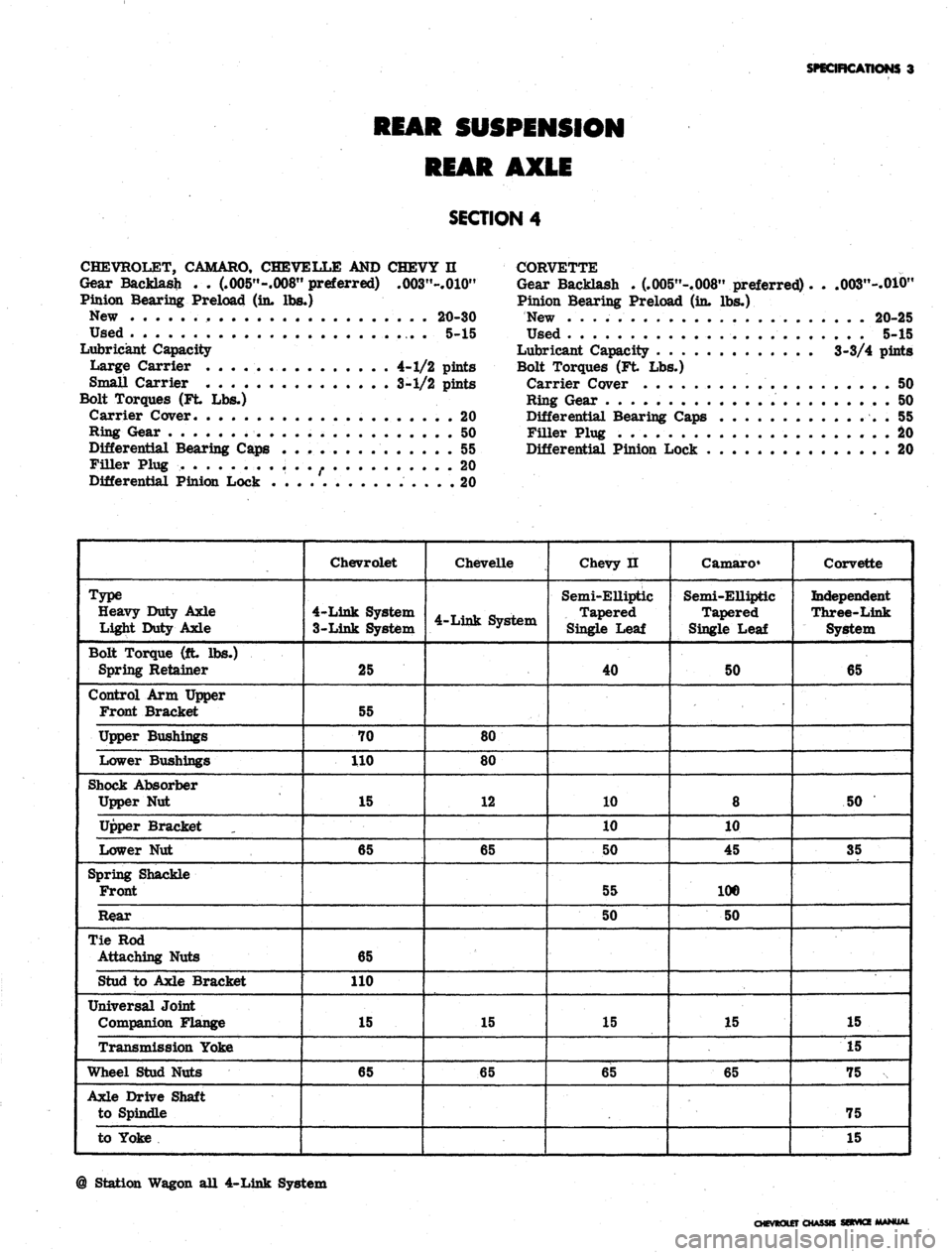
SPECIFICATIONS 3
REAR SUSPENSION
REAR AXLE
SECTION 4
CHEVROLET, CAMARO, CHEVELLE AND CHEVY II
Gear Backlash . . (.005"-.008" preferred) .003"-.010"
Pinion Bearing Preload (in. lbs.)
New 20-30
Used . 5-15
Lubricant Capacity
Large Carrier 4-1/2 pints
Small Carrier 3-1/2 pints
Bolt Torques (Ft Lbs.)
Carrier Cover 20
Ring Gear 50
Differential Bearing Caps 55
Filler Plug . . 20
Differential Pinion Lock . 20
CORVETTE
Gear Backlash . (.
005"-,
008"
preferred). . .003"-.010"
Pinion Bearing Preload (in. lbs.)
New 20-25
Used 5-15
Lubricant Capacity 3-3/4 pints
Bolt Torques (Ft Lbs.)
Carrier Cover 50
Ring Gear . 50
Differential Bearing Caps . 55
Filler Plug 20
Differential Pinion Lock 20
Type
Heavy Duty Axle
Light Duty Axle
Bolt Torque (ft lbs.)
Spring Retainer
Control Arm Upper
Front Bracket
Upper Bushings
Lower Bushings
Shock Absorber
Upper Nut
Upper Bracket
Lower Nut
Spring Shackle
Front
Rear
Tie Rod
Attaching Nuts
Stud to Axle Bracket
Universal Joint
Companion Flange
Transmission Yoke
Wheel Stud Nuts
Axle Drive Shaft
to Spindle
to Yoke
Chevrolet
4-Link
System
3-Link
System
25
55
70
110
15
65
65
110
15
65
Chevelle
4-Link
System
80
80
12
65
15
65
Chevy H
Semi-Elliptic
Tapered
Single Leaf
40
10
10
50
55
50
15
65
Camaro*
Semi-Elliptic
Tapered
Single Leaf
50
8
10
45
100
50
15
65
Corvette
Independent
Three-Link
System
65
50
35
15
15
75
75
15
@ Station Wagon all
4-Link
System
CHEVROLET a
SfRVK